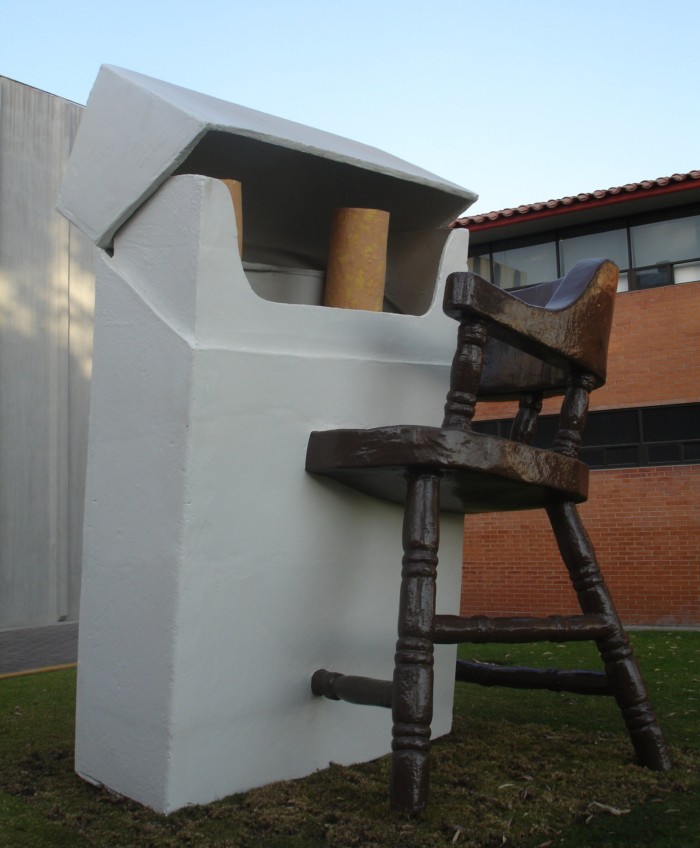Unlock the Editor’s Digest for free
Roula Khalaf, Editor of the FT, selects her favourite stories in this weekly newsletter.
Making my way down the driveway of a low-slung Modernist building in a posher part of Mexico City, I was stopped in my tracks by the cartoony monumentality of Urs Fischer’s “Bad Timing, Lamb Chop!”, an aluminium sculpture of a half-empty cigarette pack merging into a wooden chair. There’s more attention-grabbing work inside the house: to the right of the main entrance hangs Robert Rauschenberg’s “Forge”, a two-metre-high Combine piece, uniting metal, paper, a sock and a necktie, while up on a mezzanine sits Carl Andre’s emblematic “Lead Aluminum Alloy Square”. These are just a few of the works Eugenio López Alonso lives with.

López Alonso is the sole heir to Grupo Jumex, which makes Mexico’s favourite brand of packaged fruit juices, and with those resources he created Fundación Jumex in 2001 to promote the production and research of contemporary art. The foundation in turn runs Colección Jumex, with more than 3,200 artworks, and Museo Jumex, essential art institutions in Mexico City. “It all started,” he says as we talk in his library, “when I walked into Sotheby’s in 1994 wanting to buy a respectable painting.” It may have started modestly, but it has in many ways reshaped the landscape of contemporary art in Mexico City.
As a child, López Alonso says, he was very curious, “to the point of being irritating”, especially about culture and its objects, the things people surrounded themselves with and the histories that accompanied them: the golden rococo surfaces of Versailles, old dynasties as portrayed by Velázquez. His parents — “not art people, they were more into jewellery” — took him on a tour of Europe’s greatest hits and it was there that he first felt the collector’s urge. Ironically for a collector distinguished for his vision in contemporary art, “I am interested in the past more than I am in the future . . . The past is what makes us, the present we are just living in.”
He is recognised for being an early champion of the 1990s and 2000s generation of Mexican artists who, with his help, have achieved visibility in international markets and institutions. More importantly, their practices can be read within a global context, thanks in large part to the multicultural collection that López Alonso has put together, where Olafur Eliasson sits next to Abraham Cruzvillegas, Andy Warhol next to Francis Alÿs. These correspondences are evident in one of López Alonso’s many entertaining areas, where a golden Damien Hirst pill shelf and photographic Paul McCarthy works serve as backgrounds for Gabriel Orozco’s “Oval Billiard Table” (1996) and Gabriel Kuri’s “Carretilla I and IV” (1999), two wheelbarrows filled to the brim with popcorn and Christmas ornaments respectively.
By going against the grain of Mexican collections at the time — which were mostly focused on Modernism, muralism and Frida Kahlo — and through his championing of this local generation of artists, he has managed to alter the focus of Mexico’s institutions and collectors. (It also helped there were young artists hungry for a more international presence and a less nationalistic visual language.) The excitement in his voice about the success of the artists he has championed remains childlike: “I never expected it, for their value to blow up like that, it made me feel like one of those wise collectors and marchands d’art from past eras.”
He is proudest of his (free-to-enter) museum, however, and particularly that its architect David Chipperfield was in May this year awarded a Pritzker prize, his profession’s most prestigious honour. For López Alonso, this was assurance that his legacy was on the right path, that he was endowing the people of Mexico with something worthwhile. He was adamant in having a foreign architect design the headquarters of his institution when it moved from the outskirts of the city into its centre 20 years ago: “Why could Spain and the US have all these beautiful buildings designed by internationally renowned architects but not Mexico City? I wanted that for us too.”
Like his collection, López Alonso embodies this contradictory but pragmatic position, of an international perspective that focuses on growing and developing the local. Fundación Jumex is known for its expansive grant programmes for Mexican art students looking to study abroad, for the production and research of exhibitions and for the editorial projects based on them. This keeps the foundation, as he likes to put it, “significant, for generations to come”.
Part of his keeping up with the times is, obviously, a relationship with art fairs, which he values. “They bring wealth and opportunity to a city, more importantly they keep the art world going: people party there, they splurge, but art fairs also cultivate new collectors and new audiences, essential elements of a healthy art world.”
But when it comes to the market, he abhors speculation and trusts his taste. “When people start telling you how great you are, what a great eye and expensive collection you have, you start buying [according to] your ego. That’s foolish . . . speculation destroys careers, I saw that in the 1980s . . . In the end everything comes back to its rightful place.”